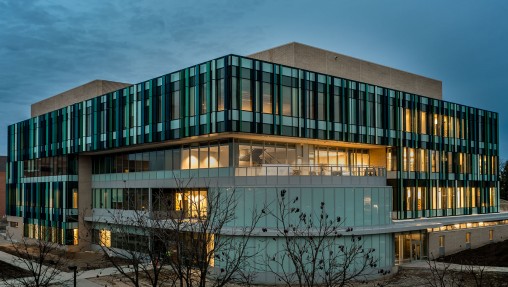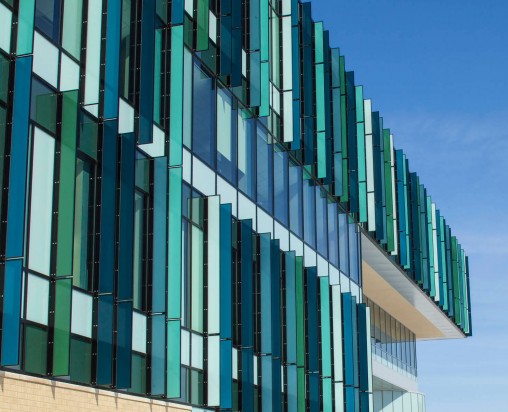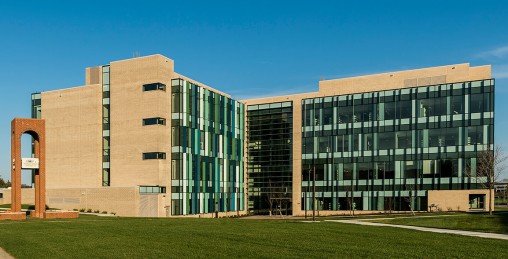
Wright State will celebrate the opening on the Neuroscience Engineering Collaboration Building with a ceremony April 16 at 4 p.m.
Wright State University’s spectacular new Neuroscience Engineering Collaboration (NEC) Building promises to spawn pioneering research and medical breakthroughs by housing the collective brainpower of almost 30 top neuroscientists, engineers and clinicians and their teams.
The four-story, L-shaped structure features two wings — one for neuroscience and one for engineering — that flank a central atrium. The building is honeycombed with laboratories and includes offices, conference rooms and a 105-seat auditorium for research symposiums.
“It is one impressive building,” said Robert Fyffe, vice president for research and dean of the Graduate School. “It represents a transformational moment for the university’s research enterprise, the community and its partners.”
The building is the first of its kind to be intentionally designed to drive research interaction across disciplines, bringing 30 researchers from six disciplines under one roof to understand brain, spinal cord and nerve disorders and develop treatments and devices.
Architectural features include chilled ceiling beams that provide a natural, energy-efficient convection air current, an anti-vibration floor that preserves the clarity of sensitive lasers and microscopes, and a dust-free sensors lab that is free of the tiniest speck.

The Neuroscience Engineering Collaboration Building’s facade is clad with hundreds of glass “fins” that provide shading and reduce heat buildup on sunny days.
About 70 percent of the facade is glass, enabling natural light to stream into the building and create an airy work environment. The facade is clad with hundreds of colorful glass “fins” that provide shading and reduce heat buildup on sunny days. In the building’s atrium is a dazzling art installation with 3-D asterisks that mimic the firing of the brain’s neurons.
“The building is amazing,” said Elliott Brown, Ph.D., the Ohio Research Scholars Endowed Chair in Sensors Physics. “It’s going to make us nationally competitive in microelectronics and nanoelectronics.”
The building is designed to foster research projects that break new ground in treating brain, spinal cord and nerve disorders by putting neuroscientists, engineers and clinicians under the same roof and creating an environment that enables them to collaborate and feed off of each other’s ideas and skills.
It houses basic researchers working to understand biological processes, clinical researchers who use that knowledge to develop treatments and cures and engineers who create medical devices and imaging technologies.
“You make sure they’re sitting in the same room, you make sure there are whiteboards all around them, you make sure there are places for them to interact at a professional and social level,” said Timothy Cope, Ph.D., director of the Wright State University and Premier Health Neuroscience Institute and chair of neuroscience, cell biology and physiology. “It will be where we bring interdisciplinary collaboration alive.”

The Neuroscience Engineering Collaboration Building will bring together scientists, engineers and clinicians to create a unique synergy between biomedical research and engineering.
The NEC Building has already become the new home for pioneering research.
For example, neuroscientists from Wright State’s Boonshoft School of Medicine and the College of Science and Mathematics are collaborating with clinicians at Johns Hopkins Medicine to determine whether they can help patients who are weakened to the point of paralysis after overcoming sepsis infection. Sepsis is a full-body inflammatory state that can lead to multisystem organ failure, coma or death. It is a complication among severely ill patients in intensive-care units.
Lead researcher Mark Rich, M.D., Ph.D., professor of neuroscience, cell biology and physiology, has devoted a large part of his career studying sepsis-related paralysis and the misbehaving motor neurons that cause it. Such medical breakthroughs are the goal of the new building.
Wright State neuroengineer Sherif M. Elbasiouny, Ph.D., has a three-year, $433,000 research grant from the Defense Advanced Research Projects Agency to try to make upper limb prostheses feel and function like natural limbs.
“Our lab being one of neuroscience and engineering is exactly the multidisciplinary nature of what the NEC Building is all about,” said Elbasiouny. “The space we’re receiving will allow us to do more work. The impact is going to be huge on the research.”
The building also houses sophisticated technologies such as an $800,000 PET/CT scanner, which marries positron emission tomography with computed tomography.
Wright State is only one of a few universities that have this body-scanning technology, which is at the forefront of medical diagnosing. It holds out the promise of helping find causes and treatments for cancer and neurological diseases such as epilepsy.
“It just opens up a whole world of opportunities we didn’t have before,” said assistant engineering professor Nasser Kashou, Ph.D.
Kashou said the scanner will be instrumental in training engineering students, strengthening research proposals and increasing their chances of being funded, and creating opportunities for Wright State researchers to collaborate with those at other universities.
The NEC Building also features a special bullpen for graduate and undergraduate student researchers such as Adam Deardorff and Emily Diller.
Deardorff is an M.D./Ph.D. student studying the nervous system to learn how people develop coordinated, purposeful movement and make small movement corrections. Diller is a biomedical engineering graduate student studying how tiny vibrations can improve a person’s fine-motor skills.
“The work that goes on in this building will truly be cutting edge,” said Fyffe, “maybe even science fiction in its nature.”
Read more about the NEC Building
Architectural features of new Neuroscience Engineering Collaboration Building hit the mark
Collaboration in new NEC Building starts with star student researchers
Wright State’s PET/CT scanner puts university at forefront of medical-diagnostic research
Collaboration between Wright State and Johns Hopkins may lead to new treatments for sepsis patients
Neuroscience Engineering Collaboration Building ushers in new art at Wright State

 Wright State psychology team studies ways to identify fatigue in pilots, drivers
Wright State psychology team studies ways to identify fatigue in pilots, drivers  Wright State videographer Kris Sproles wins Regional Emmy and Ohio journalism award
Wright State videographer Kris Sproles wins Regional Emmy and Ohio journalism award  Wright State Boonshoft School of Medicine ranked among the nation’s best for 2024 by U.S. News
Wright State Boonshoft School of Medicine ranked among the nation’s best for 2024 by U.S. News  Exposing biotechnology
Exposing biotechnology  Wright State faculty member Dan Noel uses unique background to inspire new leaders
Wright State faculty member Dan Noel uses unique background to inspire new leaders 